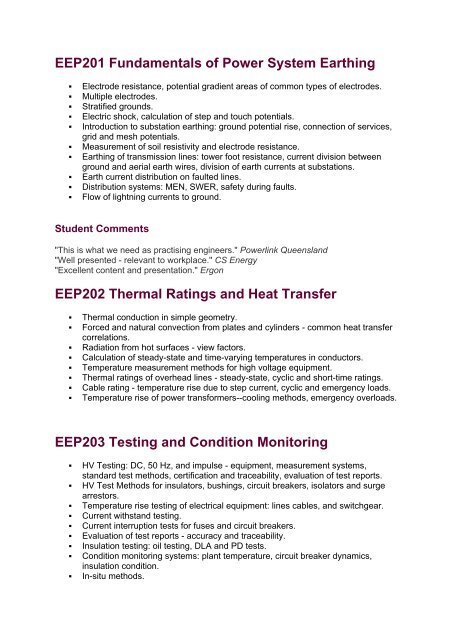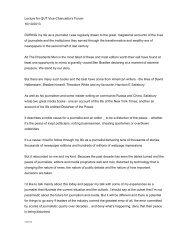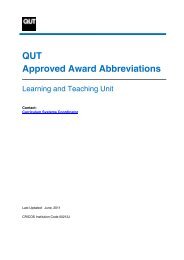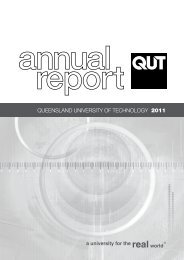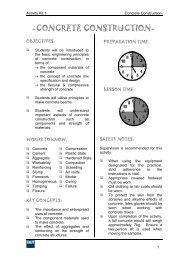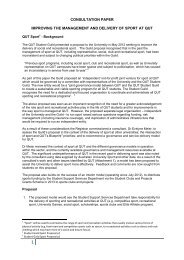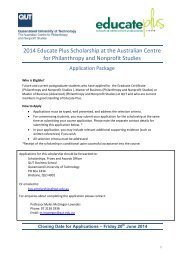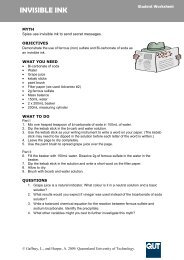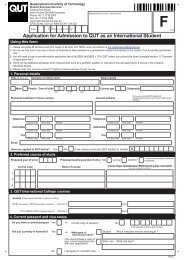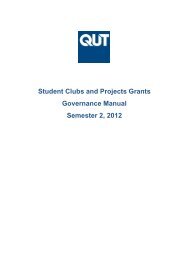EEP201 Fundamentals of Power System Earthing - QUT
EEP201 Fundamentals of Power System Earthing - QUT
EEP201 Fundamentals of Power System Earthing - QUT
You also want an ePaper? Increase the reach of your titles
YUMPU automatically turns print PDFs into web optimized ePapers that Google loves.
<strong>EEP201</strong> <strong>Fundamentals</strong> <strong>of</strong> <strong>Power</strong> <strong>System</strong> <strong>Earthing</strong>• Electrode resistance, potential gradient areas <strong>of</strong> common types <strong>of</strong> electrodes.• Multiple electrodes.• Stratified grounds.• Electric shock, calculation <strong>of</strong> step and touch potentials.• Introduction to substation earthing: ground potential rise, connection <strong>of</strong> services,grid and mesh potentials.• Measurement <strong>of</strong> soil resistivity and electrode resistance.• <strong>Earthing</strong> <strong>of</strong> transmission lines: tower foot resistance, current division betweenground and aerial earth wires, division <strong>of</strong> earth currents at substations.• Earth current distribution on faulted lines.• Distribution systems: MEN, SWER, safety during faults.• Flow <strong>of</strong> lightning currents to ground.Student Comments"This is what we need as practising engineers." <strong>Power</strong>link Queensland"Well presented - relevant to workplace." CS Energy"Excellent content and presentation." ErgonEEP202 Thermal Ratings and Heat Transfer• Thermal conduction in simple geometry.• Forced and natural convection from plates and cylinders - common heat transfercorrelations.• Radiation from hot surfaces - view factors.• Calculation <strong>of</strong> steady-state and time-varying temperatures in conductors.• Temperature measurement methods for high voltage equipment.• Thermal ratings <strong>of</strong> overhead lines - steady-state, cyclic and short-time ratings.• Cable rating - temperature rise due to step current, cyclic and emergency loads.• Temperature rise <strong>of</strong> power transformers--cooling methods, emergency overloads.EEP203 Testing and Condition Monitoring• HV Testing: DC, 50 Hz, and impulse - equipment, measurement systems,standard test methods, certification and traceability, evaluation <strong>of</strong> test reports.• HV Test Methods for insulators, bushings, circuit breakers, isolators and surgearrestors.• Temperature rise testing <strong>of</strong> electrical equipment: lines cables, and switchgear.• Current withstand testing.• Current interruption tests for fuses and circuit breakers.• Evaluation <strong>of</strong> test reports - accuracy and traceability.• Insulation testing: oil testing, DLA and PD tests.• Condition monitoring systems: plant temperature, circuit breaker dynamics,insulation condition.• In-situ methods.
Student Comments"Presenters were excellent - very knowledgable. A lot <strong>of</strong> work covered in a very shorttime." Western <strong>Power</strong>, WAEEP204 <strong>Power</strong> <strong>System</strong> Load Flow Analysis• p.u. revision.• Data collection methods.• Load flow algorithms: convergence criteria, multiple solutions, starting values,ordering and sparcity <strong>of</strong> matrices.• Single and three-phase models: transformers, tap changers, overheadtransmission lines, underground cables, capacitors and• filters, controlled reactive devices, generators and motors, load representation.• Load flow applications: base case and contingency analysis in planningaugmentation options, system operations contingency analysis.• Load flow analysis methodology--use <strong>of</strong> load forecasts, establishment <strong>of</strong> "basecase".• Practice in analysis <strong>of</strong> transmission and distribution systems using an interactivepackage.Student Comments"Well organised unit. Lectures were well prepared and informative." <strong>Power</strong>linkQueenslandEEP205 <strong>Power</strong> <strong>System</strong> Fault Calculations• Representation <strong>of</strong> generators, lines, transformers in positive sequence equivalentcircuits.• Balanced fault analysis.• Selection <strong>of</strong> source voltages from pre-fault conditions. Unbalanced faultconditions.• Complete sequence representation <strong>of</strong> power system equipment: transformers,cables and lines (including mutual coupling <strong>of</strong> parallel lines).• Per unit positive, negative and zero sequence network diagrams.• Calculation <strong>of</strong> generator and transformer sequence equivalent circuits frommanufacturer's test data.• Calculation <strong>of</strong> line sequence impedance's from line layout and soil resistivity -inclusion <strong>of</strong> tower foot resistances in zero sequence models.• Residual currents in untransposed lines.• Interference with telecommunications circuits.• Short circuit calculations to AS3581 using an interactive computer package.Recommended Prior Study: EEP204Student Comments
"Helpful and constructive. Included useful examples and applications. Well done!" Fulltimestudent"Very good industry experience - this was reflected in the lectures." Western <strong>Power</strong>, WA"Very useful and practical course." Western <strong>Power</strong>, WAEEP206 Project Management• Principles <strong>of</strong> project management and the operation <strong>of</strong> project managementpackages.• Emphasis on the practical application <strong>of</strong> PC packages based on exercises relatedto the electricity supply industry and aimed at promoting the increased use <strong>of</strong>such packages by engineering and technical staff in the normal course <strong>of</strong> theirwork.• Details include activity networks, Gantt charts, time schedules, analysis <strong>of</strong> criticalpath, types <strong>of</strong> resources, resource pr<strong>of</strong>iles, resource scheduling, projectmonitoring and reporting.EEP207 Overhead Line Route Selection -Environmental Factors• Overview <strong>of</strong> Legislation, Standards and Guides: radio interference,electromagnetic fields, low frequency induction, touch potentials, structureearthing, electrolytic corrosion, clearances, land legislation, environmental impactstatements.• Current safety and environmental issues.• Requirements <strong>of</strong> other public utilities - telecom, railways, roadworks, marine,water, gas, oil.• Cost <strong>of</strong> environmental enhancements and alternative technologies.• Right <strong>of</strong> way.• Route selection principles: structure types, terrain shielding, identification <strong>of</strong>natural and man-made features.Student Comments"Well done!" Energex"Good course and excellent value." CS Energy"Very good module. Enjoyed it!!" <strong>Power</strong>link QueenslandEEP208 Economic Analysis for <strong>Power</strong> <strong>System</strong>Engineers• Principles <strong>of</strong> economic analysis for a tax paying entity.• Various evaluation techniques are addressed including both discounted and nondiscounted techniques.• The net present value approach is settled on as being the most appropriateapproach.• Issues such as the effect <strong>of</strong> interest and inflation on nominal cash flows areaddressed.
• Cost benefit analysis for engineering decision making: econometric models forESI, maintenance, refurbishment and replacement.• Budgeting and cost control, budget preparation with spreadsheets, cash flows,monitoring expenditure and budget review, pr<strong>of</strong>it and loss and balance sheets.• Risk analysis including WACC calculations, stochastic simulation and sensitivity.Student Comments"Excellent course in terms <strong>of</strong> both material and presentation." <strong>Power</strong>link Queensland"I rate this as one <strong>of</strong> the best courses I have attended for content and presentation"Energex"The most enjoyable and informative course I have attended. Well done." <strong>Power</strong>linkQueensland"Enjoyable course. Suggest all engineers do it." Energex"The type <strong>of</strong> course I should have undertaken 2 years ago." Capricornia ElectricityEEP209 <strong>Power</strong> <strong>System</strong> Harmonics• Generation <strong>of</strong> harmonics: converters, arc furnaces, SVC, inverters, electroniccontrol.• <strong>System</strong> response characteristics: resonance conditions, effect <strong>of</strong> load, typicalsystem responses.• Effects <strong>of</strong> harmonics: motors, generators, power cables, capacitors, electronicequipment, metering, relaying, telephone interference.• Reactive power compensation and harmonic control: converter power factor,reactive power compensation, control <strong>of</strong> harmonic currents.• Measurement <strong>of</strong> harmonics.• Recommended practices including AS2279.Recommended Prior Study: EEP205EEP210 Abnormal <strong>System</strong> Voltages• Supply quality standards: review <strong>of</strong> criteria, statutory requirements, emergencyand short term limits.• 50 Hz voltage: cause <strong>of</strong> voltage deviations, voltages during faults, motor starting.• Negative phase sequence voltages: AS1359 requirements, voltage unbalancestudies, modelling, measurement.• Voltage Transients and flicker: AS2279 requirements, disturbing loads, remedialmeasures, transient disturbances and power system plant.• <strong>Power</strong> system transient analysis: ATP studies.Recommended Prior Study: EEP205EEP211 Basic <strong>Power</strong> <strong>System</strong> Protection• Protection system reliability and security.• Methods <strong>of</strong> grading protection relays.• Speed/sensitivity considerations. Comparison <strong>of</strong> "unit" and "non-unit" protection.
• Different causes and characteristics <strong>of</strong> the faults that occur on power systemsand the specific protection relays that are used to detect them.• Examination <strong>of</strong> local back-up protection.• Effects <strong>of</strong> substation configurations on protection system design andperformance.• Various types <strong>of</strong> relays - electro-mechanical and electronic.• Current and voltage transformers - theory and specification for differentapplications, including interposing current transformers.• Protection <strong>of</strong> high voltage buses.• Transformer protection - basic overview <strong>of</strong> the different types, includingdifferential protection.• Overcurrent and earth fault protection.• Inverse time relays.• Setting overcurrent and earth fault relays to achieve a co-ordinated scheme.• Instantaneous overcurrent relays.• Directional overcurrent and earth fault relays.• Reclosers, sectionalisers and fuses - application and co-ordination.• Distance relays - theory and construction.• Setting distance relays for simple applications.• Field testing and operational analysis <strong>of</strong> protection.• Commissioning and maintenance <strong>of</strong> protection systems.• Performance <strong>of</strong> protection under fault conditions.• Information available for the analysis <strong>of</strong> protection performance.Recommended Prior Study: EEP205Student Comments"A first class presenter with excellent notes and pr<strong>of</strong>essional teaching style." <strong>Power</strong>linkQueensland"Very well presented unit." <strong>Power</strong>link Queensland"Very thorough and comprehensive." Capricornia Electricity"Thanks. Very enjoyable - backs up 10 years <strong>of</strong> practice." S W <strong>Power</strong>EEP212 Advanced <strong>Power</strong> <strong>System</strong> Protection• High impedance protection <strong>of</strong> power system plant (busbars, motors, generators,reactors & capacitors) including CT requirements, the application <strong>of</strong> shunt andseries resistors, non-linear resistors, check schemes, back-up schemes and CTsupervision.• Protection <strong>of</strong> transformers, including biased and high impedance differentialschemes as well as aspects related to earthing transformers.• Feeder differential protection, including pilot wire, current differential and phasecomparison schemes.• Protection <strong>of</strong> high voltage capacitor banks, including consideration <strong>of</strong> inrushcurrents, overcurrent, over voltage, balance, and differential protection schemes.• Application <strong>of</strong> single and three pole autoreclosing schemes to HV and EHVtransmission systems.
• Protection <strong>of</strong> large motors, including differential and earth fault protection, thermaloverload considerations, starting & stalling currents and the effect <strong>of</strong> negativephase sequence currents.• Protection <strong>of</strong> large generators, including stator & rotor earth fault protection,biased differential, high impedance differential, negative phase sequence, underfrequency, over excitation, reverse power and out-<strong>of</strong>-step protections.Recommended Prior Study: EEP211Student Comments"Excellent." Integral Energy"A very informative course, it explains a lot <strong>of</strong> what I have been doing." Energex"Very relevant to my day to day job." Snowy Hydro"Tim tams and mints were really good." <strong>Power</strong>link QueenslandEEP213 Statistics• The role <strong>of</strong> statistics in electricity supply engineering.• Strategies for collecting and recording valid data from which statistical inferencescan be made; use <strong>of</strong> operational and inventory data.• Graphical and numerical techniques to summarise data using statistical orspreadsheet packages.• Review <strong>of</strong> probability concepts, random variables, probability distributions.• Specific distributions used in system and component reliability studies.Student Comments"The course was very good because it was very well structured and presented. The bestaspect was that a theoretical subject was presented as a tool to solve practical problemsand problems were relevant, real engineering problems." Energy AustraliaEEP214 Risk Assessment in the Electricity SupplyIndustry• Identification <strong>of</strong> hazards: failure modes and effects analysis, failure modes effectsand criticality analysis - outcomes from possible failure modes.• Hazard and operability studies.• Assessment <strong>of</strong> frequency - fault tree analysis, event tree analysis.• Assessment <strong>of</strong> consequences: consequence analysis, criticality assessment interms <strong>of</strong> chance <strong>of</strong> failure and consequences, incident scenario, damage criteria,damage identification.• Legal and economic consequences.• Case studies including identification <strong>of</strong> hazards, assessment <strong>of</strong> risks, andconsequences in ESI.• Loss <strong>of</strong> load models in generation.
Recommended Prior Study: EEP215EEP215 Reliablility• Basic reliability concepts.• Reliability analysis methods.• Reliability methods.• Application <strong>of</strong> important distributions.• Failure rate, repair time and mean time failure.• Reliability <strong>of</strong> series, parallel and complex systems.• Discrete Markov Chains.• Continuous Markov processes.• Frequency and duration in reliability.• Application <strong>of</strong> Markov Chain in the reliability evaluation <strong>of</strong> repairable systems.• Application <strong>of</strong> reliability evaluation in power distribution systems, inclusion <strong>of</strong> costestimation.• Reliability assessment in subtransmission system planning, including nonconstanttransition rate considerations.• Study <strong>of</strong> single and double contingencies with switching to restore supply.• Inclusion <strong>of</strong> maintenance in system modelling.• Probability and frequency <strong>of</strong> loss <strong>of</strong> load.• Unsupplied energy and average load at risk.• Maximum load at risk.• Average outage duration.• Hours <strong>of</strong> Loss <strong>of</strong> load.Recommended Prior Study: EEP213EEP216 Overhead Line Design - Electrical• Electrical design <strong>of</strong> transmission lines with ratings <strong>of</strong> 33kV to 500kV.• Economic conductor size.• Characteristics <strong>of</strong> conductors.• Standard and new technology insulators: power frequency, impulse and switchingflashover voltage, pollution and creepage, wet and dry flashover, mechanicalcharacteristics.• Feasible structure types.• Tower footing resistance and counterpoise.• Insulation co-ordination methodology: determination <strong>of</strong> overvoltage withstand,design for required outage.• Determination <strong>of</strong> RI using state <strong>of</strong> the art methods.• Design to ensure that electrostatic and electromagnetic fields do not exceed NH& MRC guidelines.Recommended Prior Studies: <strong>EEP201</strong>, EEP203, EEP207, EEP210Student Comments
"I was much more impressed with the presentation <strong>of</strong> the notes for this course. TheEEP216 notes are <strong>of</strong> the level we would expect from your courses and, coupled with agood presenter like Tony, the course should be beneficial to our staff both immediatelyand in the longer term." Energy AustraliaEEP217 Overhead Line Design - Mechanical• Conductor selection.• Catenary theory.• Sag-tension-temperature calculations.• Requirements for survey data.• Statutory and enterprise requirements for line layout: clearances, mechanicalloading, safety criteria.• Definition <strong>of</strong> loading conditions, structure capacities, layout clearances.• Applied mechanics <strong>of</strong> strung conductors.• Determination <strong>of</strong> everyday tensions from allowable stress or tension/mass ratio.• Determination <strong>of</strong> vibration protection.• Transmission line estimating techniques.• Selection <strong>of</strong> structure type based on optimum capitalised costs.• Line layout.Recommended Prior Studies: EEP208, EEP216Student Comments"Terrific! I needed this course or similar about 10 years ago." Mackay Electricity Corp"Excellent course" Dunedin Electricity (NZ)"Great course. Enjoyed immensely and feel much more confident <strong>of</strong> producing correct,efficient overhead designs. Thanks." Mackay Electricity Corp"Very good. Practical and useful material." <strong>Power</strong>link Queensland"This is one <strong>of</strong> the most useful and practical courses I have done." EnergexEEP218 Introduction to Automated <strong>System</strong> Controland Supervisory <strong>System</strong>s (SCADA)• SCADA fundamentals and protocols.• SCADA equipment: master station, remote terminal units.• Transmission SCADA systems, distribution automation systems, distributioncontrol systems, PC s<strong>of</strong>tware applications.• Alarm philosophy and control principles: definition <strong>of</strong> system displays, datalogging, database point processing and attributes, master station configuration.• Specification <strong>of</strong> MMI: identification <strong>of</strong> system functional requirements.• Computer system platforms: computer technology fundamentals, computerhardware - processors, peripherals, display, user interfaces.• Communication system principles, communications bearer fundamentals, datanetworks and protocols.• Data communications and I/O capacities and types, I/O processing. Application <strong>of</strong>SCADA systems to transmission and distribution systems.• Cost/benefits <strong>of</strong> alternative schemes.
Contact Hours: 15 hoursEEP219 High Voltage Substation Equipment: <strong>Power</strong>Transformers and Reactive <strong>Power</strong> Plant• Principles <strong>of</strong> power transformer design from distribution transformers to EHVtransformers: ratings, windings, core structure and materials, insulation andcooling methods, insulation and lifetime.• Leakage and magnetising reactance.• Losses, harmonics and inrush currents.• Short circuit forces.• Tests to measure: ratio, losses, impedance, phasing, temperature rise, accuracyand traceability <strong>of</strong> tests, interpretation <strong>of</strong> test reports.• Surge phenomena in windings, RSG and impulse testing <strong>of</strong> power transformers,interpretation <strong>of</strong> test results.• Oil cooling systems.• Fire protection.• Tap changers and associated controls.• Analysis <strong>of</strong> transformer failure modes.• In-phase and quad-boost regulators.• Series and shunt reactors.• Reactors for harmonic filters.• SVCs: design considerations, equipment characteristics and equipmentcharacteristics.Recommended Prior Study: EEP203Student comments"The best course I have done this far." Alstom Australia"Hard to fault. Well organised, practical." ETSA UtilitiesEEP220 Distribution Planning• Identify data and techniques used in load forecasting.• Examine typical distribution network problems and identify performancelimitations based on standards.• Relate network problems to different configurations and the effects on customers.• Study network reinforcement options on a simulation package.• Options include regulators, series and shunt capacitors and reconductoring.• Consider the above options to address a realistic network problem assessing linelosses and voltage results.• Analyse network reliability and assess the impact <strong>of</strong> ties, switches and variousnetwork configurations.• Compare alternatives based on economic and technical considerations.• Prepare a logical case which recommends one option in the form <strong>of</strong> a report.
Recommended Prior Studies: EEP208, EEP211,EEP219Student Comments"Well presented. Well written and structured course notes." EnergexEEP221 Limits to <strong>Power</strong> <strong>System</strong> Stability• Time domain models and characteristics <strong>of</strong> synchronous machines.• Induction generator models.• Assessment <strong>of</strong> model bandwidth for use in dynamic studies.• Excitation system models, turbine governor models, boiler models, hydraulicsystem models.• Characteristics <strong>of</strong> load plant.• Evaluation <strong>of</strong> small signal adequacy by eigenvalue analysis.• Determination <strong>of</strong> modes <strong>of</strong> electromechanical and control systems.• Identification <strong>of</strong> modes with insufficient damping, eigenvalue participating statesand eigenvectors.• Establishment <strong>of</strong> transfer evaluation <strong>of</strong> gains/phases at identified modelfrequencies.• Time domain dynamic simulations <strong>of</strong> power system operation.• Numerical models for prediction <strong>of</strong> large disturbance behaviour <strong>of</strong> interconnectedpower systems.• Stability <strong>of</strong> system under contingency and emergency conditions.• Stability improvement using: controlled reactive devices, special control systems,braking resistors, U/F load shedding, FACTS.Recommended Prior Study: EEP205EEP222 Maintenance <strong>of</strong> Electricity Supply <strong>System</strong>s• Establishment <strong>of</strong> maintenance policies: review <strong>of</strong> failure rates, emergencyspares, identification <strong>of</strong> maintenance liabilities, identification <strong>of</strong> critical successfactors to minimise life cycle costs, approval and dissemination <strong>of</strong> policy, policyreview.• Maintenance planning: identification <strong>of</strong> constraints, review <strong>of</strong> existingmaintenance programs, establishment <strong>of</strong> plans for periodic actions,documentation <strong>of</strong> procedures, design <strong>of</strong> reporting procedures.• Data recording and analysis: registers <strong>of</strong> defects, design <strong>of</strong> data collection andreporting systems, preparation <strong>of</strong> control charts, computer systems, data basedevelopment.• Maintenance Operations: identification <strong>of</strong> refurbishment needs, resourceevaluations, design <strong>of</strong> work procedures, impact <strong>of</strong> Acts and regulations,identification <strong>of</strong> staff training needs, supervision, auditing <strong>of</strong> work practices.• Maintenance program evaluation: assessment against KPI, modification <strong>of</strong>programs to account for continuing defects and failures or to reflect changingtechnologies.
Recommended Prior Study: EEP214Student Comments"Quite impressed! Well structured, logically ordered, well presented, good balancebetween theory and practical. Liked tutorials - helped to understand content. Onlyproblem - course too short." Capricornia Electricity"It is good to do a course that is specifically based on electricity industry experience,presented by someone with practical knowledge <strong>of</strong> the maintenance work." CapricorniaElectricity"It is good to do a course that is specifically based on electricity industry experience,presented by someone with practical knowledge <strong>of</strong> the mainenance work." CapricorniaElectricity"Excellent course and presentation." Hydro Electric Corporation"The course was very interesting. Excellent overall." ETSA Transmission"Very good!!" CS Energy"Completely new subject to me - most interesting and some very relevant examplesused. Will result in me questioning some maintenance decisions in future." Counties<strong>Power</strong>, N.Z.EEP223 Load Forecasting• Nature <strong>of</strong> load patterns: historical patterns, links between customers and loadsand between energy and demand demographics.• Categories <strong>of</strong> DSM, costs <strong>of</strong> DSM options, benefits, and limitations to DSM.• Tariffs and their impact.• Impact <strong>of</strong> economic trends on demand growth.• Load manipulation.• Load forecast methods: data collection and availability, weather correction,interpreting data, synthesising missing data, developing load forecast data,developing alternative scenario load forecasts.• Establishment <strong>of</strong> base loads from: historical load data, customer load predictions,and other contributing factors.• Prediction <strong>of</strong> growth rates.• Generation <strong>of</strong> load forecasts.Recommended Prior Study: EEP213EEP224 Underground Cable Engineering• A look at the conducting and insulating materials used in modern cable designand factors the lead to their development.• The electrical characteristics that describe the performance <strong>of</strong> insulated cablesand a short qualitative look at the background theory.• An examination <strong>of</strong> aspects <strong>of</strong> cable systems design:• Different types <strong>of</strong> cable ratings• <strong>Earthing</strong>, induced voltages and bonding <strong>of</strong> cable sheaths• Electromagnetic fields around underground cables• Characteristics and measurement <strong>of</strong> soil thermal parameters.
• An overview <strong>of</strong> manufacture, testing and standards for insulated cables• Some notes on cable accessories• A study <strong>of</strong> the underground cable circuit planning, design and installation:• Concept design/feasibility studies and cost estimates• Details design, permits and approvals• Civil and electrical construction and testing• Considerations in the management <strong>of</strong> an underground cable installation:• Important aspects <strong>of</strong> safety• Considerations <strong>of</strong> ratings including the importance <strong>of</strong> a knowledge <strong>of</strong> thecable environment• Factors that affect cable ageing <strong>of</strong> different types <strong>of</strong> cables• A look at maintenance practices, monitoring systems and diagnostics.• A brief look at fault locationRecommended Prior Study: EEP202, EEP212, EEP214, EEP221, EEP223EEP240 Organisation and Financial Management inthe ESI• Financial reporting, including pr<strong>of</strong>it and loss and balance sheet.• Interpretation <strong>of</strong> financial data and commercial practices with respect to variousline items in financial reports.• Key performance indicators, the derivation, interpretation and pitfalls.• Financing arrangements.• Taxation issues that affect the industry including income tax, repairs, tax effect <strong>of</strong>depreciation and capital gains tax.• Various asset management issues including inventory and fixed assets.• Cost volume pr<strong>of</strong>it analysis including break-even, contribution margin and EBIT.Student Comments"Excellent - more subjects <strong>of</strong> this nature in the course please!" EnergexEEP241 Distance Protection• Current transformers: transient performance, saturation factors and effects ondistance relay performance.• Voltage transformers: transient performance and effects on distance relayperformance.• Distance protection: select a suitable relay characteristic based on anunderstanding <strong>of</strong> relay comparator operation (amplitude and phase anglecomparators), implement non-switched distance protection schemes, implementswitched distance protection schemes (including allowance for various startercharacteristics), allow for the effects <strong>of</strong> mutual coupling with other feeders, designprotection schemes and set relays for teed feeder systems and also for bridgedor paralleled feeder configurations, allow for the effects <strong>of</strong> arc and/or faultresistance, ensure that load encroachment does not cause inadvertent tripping,ensure healthy phase fault currents do not degrade distance relay performance,
develop a grading plan to ensure coordination with protection relays (includingIDMT relays) elsewhere on the power system, understand relay functions such asswitch-onto-fault logic, VT supervision, memory, power swing blocking andhealthy phase polarising.• Protection signalling: direct, series, permissive (overreaching andunderreaching), distance acceleration and blocking intertripping.Recommended Prior Study: EEP211Student Comments"Excellent!" Far North Queensland Electricity Corp"I really liked the working through from first principles." TransGrid"A very well presented course from a very knowledgable presenter." ETSAEEP242 Efficient Marketing and Utilisation <strong>of</strong>Electricity: Demand and Supply Side Solutions• Assessment <strong>of</strong> future DSM options: state, national and international DSMprograms assessed; local opportunities examined; impact <strong>of</strong> new and evolvingtechnology; compare options and select for cost effectiveness, load impact andcommunity acceptance.• Determination <strong>of</strong> avoidable costs: assessment <strong>of</strong> marginal cost <strong>of</strong> supply andidentification <strong>of</strong> unavoidable and avoidable costs.• Survey <strong>of</strong> customer needs and wants: conducting market research; application <strong>of</strong>existing tariffs or development <strong>of</strong> new tariffs.• Planning and estimating market potential for DSM: comparison <strong>of</strong> options todevelop the optimum plan to meet customer needs and supply authorityrequirements.• Economic comparison <strong>of</strong> DSM and SSM options for a specific project includingcombined options.• Design and implement DSM program: targets, resources, in-house or contract.• Monitoring program performance.• Assessment <strong>of</strong> DSM on local and system load forecasts.Recommended Prior Studies: EEP208; EEP223EEP243 Contract Administration• Categories <strong>of</strong> contracts: supply; supply deliver & erect; performance guaranteed;services e.g. maintenance; period for supply <strong>of</strong> stock items or services.• General conditions <strong>of</strong> contract: terms <strong>of</strong> payment and security deposit; qualityassurance procedures; retention conditions.• Special conditions <strong>of</strong> contract: delivery and penalties for delay; technicalprovisions; penalty/bonus for such factors as efficiency, performance,maintenance and reliability.• Pre-tender acceptance negotiation practice.
• Evaluation <strong>of</strong> tenders: tender adjustments; determination <strong>of</strong> the lowestcomparatively priced <strong>of</strong>fer on a total capitalised cost basis which conforms withthe specified technical and commercial requirements.• Tender acceptance; contract correspondence; drawings - standards, amendment.• Contract law, dispute resolving procedures.• Contract progress monitoring: approval <strong>of</strong> drawings and documents; approval <strong>of</strong>delivery, erection, site testing.• Acceptance, take over, maintenance period, retention provisions.Recommended Prior Study: EEP208Student Comments"This is the only contract administration course that I am aware <strong>of</strong> where the examplesand participants are from my industry. Very well done!!" Rail Services Authority (NSW)"Recommended for all people associated with contract administration - they should dothis course." CS Energy"Very Good. Opened my mind to a range <strong>of</strong> areas where I could cause major contractproblems, and lose a lot <strong>of</strong> money." CS Energy"Greg Kenny is in a class <strong>of</strong> his own - to be able to present such a boring subject in suchand enjoyable manner." Rail Services Authority (NSW)EEP244 Circuit Breakers - Switchgear• Basic switching theory for the main circuit breaker types: SF6, Vacuum, GIS,minimum oil, airbreak (11kV), bulk oil; characteristics and applications for thesetypes at various voltage levels.• Circuit-breaking principles: interruption <strong>of</strong> load current, small inductive current,short-line faults and out-<strong>of</strong>-phase switching.• TRV and ITRV concepts.• Direct and synthetic testing.• Technical specifications <strong>of</strong> circuit breakers: operating voltage; impulse withstand;rated current; interrupting capacity; switching duties; operating mechanisms -single or 3 pole; clearing time; environment.• Selection <strong>of</strong> circuit breakers: analysis <strong>of</strong> tenders on a whole <strong>of</strong> life basis.• Circuit breaker failures: failure modes for different types; catastrophic failures;category <strong>of</strong> failure - design, operating or maintenance cause; reliability.• Circuit breaker testing and condition monitoring.• Circuit breaker maintenance and refurbishment.• Emerging circuit breaker technology.Recommended Prior Study: EEP210EEP245 Introduction to Substation Design• Preparation <strong>of</strong> design/site options: standard layouts (outdoor, indoor, GIS,package, single bus, 11/2 CB et) - cost, site, reliability lead time andcommunication factors; estimating procedures.
• Comparison <strong>of</strong> design/site options; whole <strong>of</strong> life cost comparison including capitaland operatic costs; environmental and public issues.• Identification <strong>of</strong> design parameters: voltages, ratings, protection, metering,SCADA, communication, operational - preparation <strong>of</strong> one-line diagram andgeneral arrangement; design scope; review with other parties.Recommended Prior Studies: EEP202; EEP219; EEP244EEP246 Customer Metering• Tariff structures network and retail, and how they effect metering systems.• Metered parameters, kW, kWh, var, varh, VA, VAh, power factor, demand andthe interrelationships between them.• Electronic metering multifunction, measurement methods used by electronicmeters, advantages and limitations <strong>of</strong> various techniques.• High voltage metering, import / export metering the techniques used, limitations,Blondel's theorem, safety aspects.• Current and Voltage transformers, their use in metering, theory <strong>of</strong> operation andaccuracy limitations.• Metering in the deregulated market and in particular the requirements <strong>of</strong> Chapter7 <strong>of</strong> the National Electricity Code.• Brief description <strong>of</strong> single and polyphase electromechanical metering, the method<strong>of</strong> operation and the techniques used to measure reactive power.• The use <strong>of</strong> electronic registers, summation registers and other techniques forcustomers with multiple points <strong>of</strong> supply.• Communications methods used in remote meter reading.• Standards and regulatory bodies international and Australian.Student comments"Excellent. I learned a lot." Ergon Energy"A very worthwhile course." EnergexEEP248 Introduction to Electricity Markets• Economic models <strong>of</strong> markets (e.g. monopoly, oligopoly, monopolistic competition,perfect competition.)• Application to the electricity supply industry.• Spot market operations and Ch.3 <strong>of</strong> the National Electricity Code.• Theory <strong>of</strong> derivatives.• Using electricity derivatives to manage spot price risk.• Electricity market simulation.• Deriving transmission/distribution revenues in the National Electricity Market.Student comments"Totally covered the course syllabus. I really enjoyed the subject!" CS Energy"Well presented and interesting course." Full-time student


